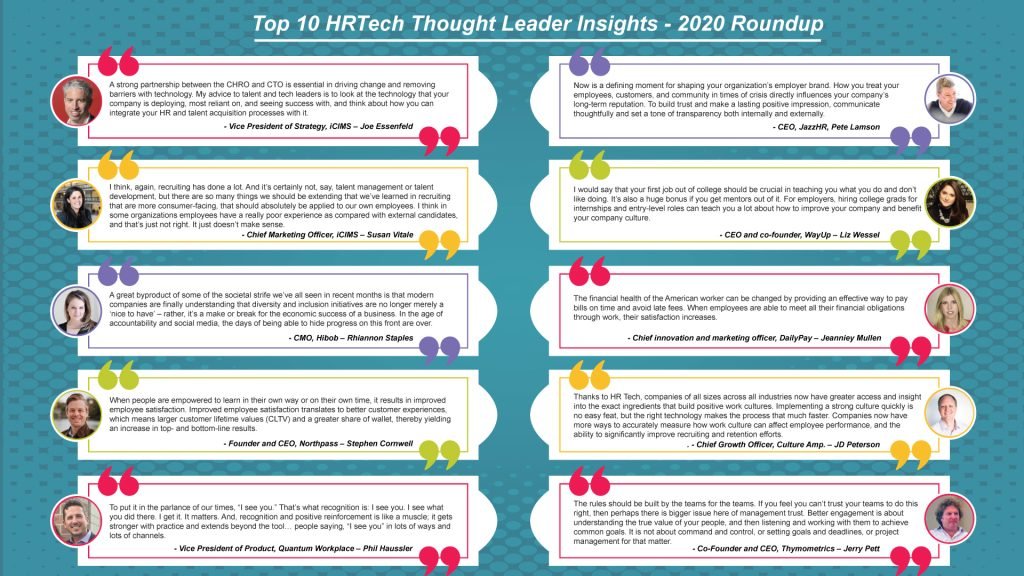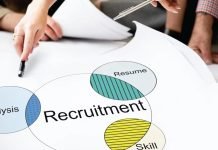Retrospecting & Learning from what the leaders of the HRtech community have shared with us in the previous year, we bring to you some of the most intriguing insights.
And, it’s a wrap! With the blink of an eye we are in 2021, which hopefully will be full of tenacity to innovate to advance. You will probably see many people making resolutions revamp their lives and make it a runway to success, but you will see a minimal number of them actually sticking to their commitments. This often happens because of either the lack of interest of unrealistic goals. Now, in order to make goals that are achievable and are significant to cross the finish line, you will first need to analyze your previous strategies and take newer variables and constraints into consideration. And, if you are starting afresh, you will need some insights from someone who is a subject-matter expert.
Let’s say you decide you want to get a promotion at work this year. So, what do you do about it? You will look up to your mentors for guidance and breakdown your achievements and performances into different sets and compare them with those of your seniors to identify any gaps and shortcomings that you may need to work on, to get that promotion. Now, of course, no people or organizations are the same, and they do have their own individual journeys, but it is always helpful to learn from people who have been down on the same road and are now on the other side of it.
When you learn from people who have worked to reach where they are, you will find a lot of expertise instilled in how they do things now, and how they got there. It is not necessary for you to do the exact same thing, but taking inferences and inspiration from leaders has always proven to be a great motivator.
We, at HRtechcube, believe a lot in embryonic development as well as enhancement at later stages, and we also believe that retrospecting at what the leaders have said and dissecting it down to the bone can help us better in formulating our future policies and processes.
So, here are some of our favorite leader insights from 2020 that we found extremely intriguing and perennial to reversing obstinacy from the HRtech industry.

1) A strong partnership between the CHRO and CTO is essential in driving change and removing barriers with technology. My advice to talent and tech leaders is to look at the technology that your company is deploying, most reliant on, and seeing success with, and think about how you can integrate your HR and talent acquisition processes with it. – Vice President of Strategy, iCIMS – Joe Essenfeld
Every team has a chemistry within and its own way of working in synchronicity. And, the executive team is always on a loot out for high-tech tools that can get them better results. A lot of times the management integrates a newer technology into the existing workflow of the company with the aim of amplifying the performance. But, often they end up disrupting the set flow of work and frictional transition, because of the lack of compatibility between the teams and technology.
Tech is supposed to be a member of the team and not a disruptor. So, it is important that tech leaders analyze and evaluate their existing tech stack and figure out ways of enhancing it, so that the teams are aided with advancements, but are still in sync with their flow of work.
2) I think, again, recruiting has done a lot. And it’s certainly not, say, talent management or talent development, but there are so many things we should be extending that we’ve learned in recruiting that are more consumer-facing, that should absolutely be applied to our own employees. I think in some organizations employees have a really poor experience as compared with external candidates, and that’s just not right. It just doesn’t make sense.– Chief Marketing Officer, iCIMS – Susan Vitale
When organizations focus on attracting the top industry talent, they go all out. We have seen firms painting a beautiful picture of how the lives of their employees are like at the organizations which is totally reversed of what the reality is. So, while the top talent is attracted to this picture, organizations do not even realize that their own employees think it’s a façade. So, lessons from recruiting and consumer experiences can be extracted and implemented to the management and experiential activities of the firms’ workforce.
And, the reason why it is so important to do this, is because your employees are your company. If they have poor experience within the organization, it is only a matter of time, before your organizational processes and brand come crumbling down.
3) A great byproduct of some of the societal strife we’ve all seen in recent months is that modern companies are finally understanding that diversity and inclusion initiatives are no longer merely a ‘nice to have’ – rather, it’s a make or break for the economic success of a business. In the age of accountability and social media, the days of being able to hide progress on this front are over. – Chief Marketing Officer, Hibob – Rhiannon Staples
DE&I is an element that is going to decide the present and the future of the company. As more and more people understand the crux of the problem, the reforms and the transformation processes get accelerated. Now, organizations can no longer claim that they are committed to removing bias and discrimination without actions supporting their claims.
Even the candidates that may be interested in working with the company, might choose to go the other way if they feel that the firm is not in progression with the current times and reforms to DE&I, making it difficult for organizations to sustain in the society.
When George Floyd was kneed in his neck for 8 minutes 46 seconds by the white policeman, Derek Chauvin, he ended up being killed because of the color of his skin. “I can’t breathe, Sir”, is what George said till the time he fell unconscious.
We have to create a safe place for people of every color, sexual orientation, abilities, social backgrounds. We need policies in place that ensure that everybody can breathe and live their lives to the fullest. Big industry influencers such as Apple and Google are going beyond their workforce and educating and creating awareness about such issues with the help of their conversational assistants, Google Assistant and Siri.


So, it is necessary for organizations to take a stand and eradicate any kind of discrimination or favorism going on in their firm by communicating and educating their workforce about the problem and the solution – DE&I.
4) When people are empowered to learn in their own way or on their own time, it results in improved employee satisfaction. Improved employee satisfaction translates to better customer experiences, which means larger customer lifetime values (CLTV) and a greater share of wallet, thereby yielding an increase in top- and bottom-line results.– Founder and CEO, Northpass – Stephen Cornwell
Learning and Development initiatives backed by powerful adaptive solutions is the need of the hour. With such empowerment to learn and advance in the careers, organizations can have their employees reach the optimum level of satisfaction which in turn will definitely prove to be beneficial for the core business of the organization.
When the pandemic crisis first came to notice, NBK raised its motto of putting the safety of its employees and customers first. That is also when the bank decided to accelerate the remote training and development of its staff to refine their skills. 86% of the bank’s employees underwent mandatory remote training courses via the banks’ e-learning platform. Going an extra mile, the bank also made arrangements for its staff to have flexi work hours, so that they can begin setting up things for the online learning of their kids, smoothly.

It is a lot about what the firm does for the L&D and experience of its employees that decides its success-failure ratio.
5) To put it in the parlance of our times, “I see you.” That’s what recognition is: I see you. I see what you did there. I get it. It matters. And, recognition and positive reinforcement is like a muscle; it gets stronger with practice and extends beyond the tool… people saying, “I see you” in lots of ways and lots of channels. – Vice President of Product, Quantum Workplace – Phil Haussler
Appreciation is your answer to motivate your workforce to do better as well as your way of showing gratitude towards their efforts. Knowing that their contribution is being seen and recognized makes them more vigilant and keen to show their belongingness to the firms through their performance. It’s like a pendulum that sways from appreciation and recognition to performance and improvement.
6) Now is a defining moment for shaping your organization’s employer brand. How you treat your employees, customers, and community in times of crisis directly influences your company’s long-term reputation. To build trust and make a lasting positive impression, communicate thoughtfully and set a tone of transparency both internally and externally. – CEO, JazzHR, Pete Lamson
As organizations grow, so does their workforce. And, a positively known brand is one of the major USPs for any enterprise. Creating an employer brand goes beyond advertising, job descriptions, and candidate experiences. It is a factor that is highly impacted by all stakeholders of the firm. So, to shape up their employer brand, organizations create an ecosystem that welcomes each and every type of person to an atmosphere of beneficially and experientially elevated teams.
Such teams and ecosystems can be created by integrating attributes such as putting in in place programs and practices such as employee advocacy, open door policy, L&D, individualized career pathing, DE&I training, collaborative workshops for skills enhancement, fair performance reviews, health and wellness benefits, culture building, and community care initiatives. Your employees will be your brand advocates if you do all that is necessary to deliver an enhanced experience.
7) I would say that your first job out of college should be crucial in teaching you what you do and don’t like doing. It’s also a huge bonus if you get mentors out of it. For employers, hiring college grads for internships and entry-level roles can teach you a lot about how to improve your company and benefit your company culture. – CEO and Co-Founder, WayUp – Liz Wessel
While we look at onboarding talent, we often go after candidates that have proven their worth by working at different organizations, i.e. a candidate that has a robust work experience. But, we tend to overlook the fact that there are fresh grads that have the most up-to-date knowledge and are looking for organizations that can mark the beginning of their careers, impactfully. Enterprises can create an environment or consistent learning by mentoring freshers.

8) The financial health of the American worker can be changed by providing an effective way to pay bills on time and avoid late fees. When employees are able to meet all their financial obligations through work, their satisfaction increases. – Chief Innovation and Marketing Officer, DailyPay – Jeanniey Mullen
Giving employees a control over their earnings as well as the power to manage their finances without down the debt funnel, is one of the most needed and innovative ways of creating an employer-employee bond that is not limited to the traditional work-pay cycle. Organizations can now be a part of the lifestyle improvement processes of their employees, all the while reducing their cost of turnover.
9) Thanks to HR Tech, companies of all sizes across all industries now have greater access and insight into the exact ingredients that build positive work cultures. Implementing a strong culture quickly is no easy feat, but the right technology makes the process that much faster. Companies now have more ways to accurately measure how work culture can affect employee performance, and the ability to significantly improve recruiting and retention efforts. – Chief Growth Officer, Culture Amp. – JD Peterson
It is astonishing how technology can bring a cogent culture that influences the entire organizational value and performance. Paired with the people-driven teams, technology can accelerate the culture shaping efforts of employers that in turn drive their practices to gauge engagement. Engaging your employees with the deeply rooted belief-system of your business will create a lasting relationship.
10) The rules should be built by the teams for the teams. If you feel you can’t trust your teams to do this right, then perhaps there is a bigger issue here of management trust. Better engagement is about understanding the true value of your people, and then listening and working with them to achieve common goals. It is not about command and control, or setting goals and deadlines, or project management for that matter. – Co-Founder and CEO, Thymometrics – Jerry Pett
Looking at objectives from a managerial point of view, doesn’t just mean numbers and spreadsheets. Management is supposed to guide teams and not dictate them. So, it is safe to say that creating the bridge of trust between the management and the employees, could mean for the employees to walk on the pathway of loyalty and success.
We are really thankful to all the leaders who were benevolent enough to express their thoughts and offer their insights on our platform. Entering the New Year with all the gratitude that we can have, we hope 2021 to be the year of people, personalization, and performance, that can be our catalyst to creating a satisfied post-pandemic workforce.
For more such Updates Log on to www.hrtechcube.com
ABOUT THE AUTHOR


Chandrima Samanta
Content-Editor at HrTech Cube
Chandrima is a Content management executive with a flair for creating high quality content irrespective of genre. She believes in crafting stories irrespective of genre and bringing them to a creative form. Prior to working for MartechCube she was a Business Analyst with Capgemini.













